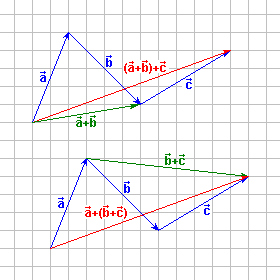|
ACTIVITY 2.4 |
|||
|
In this activity we will prove the asociativity of the vector sum working with components. If
You observe that the demonstration that we have made is based on in the asociativity of the number sum. |
 |
|
INTERACTIVE ACTIVITY This construction demonstrates that the vectors ( You check the components of vectors |
| HOMEWORK |
Given the vectors![]() = (-2, 4),
= (-2, 4), ![]() = (5, 2),
= (5, 2), ![]() = (1, -3),
= (1, -3), ![]() = (-7, 4),
= (-7, 4), ![]() = (-4,0) and
= (-4,0) and![]() = (5, -6,) you make the following sums vectors
representing them in a squared paper:
= (5, -6,) you make the following sums vectors
representing them in a squared paper:
|
1) ( |
2) |
3) ( |
4) |
|
END OF ACTIVITY 2.4 |
|||